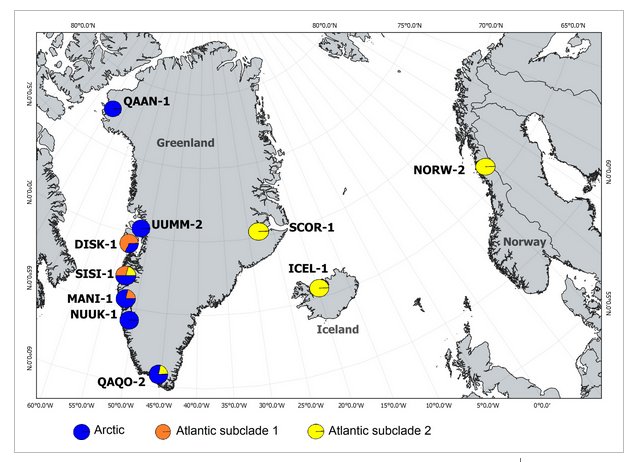A melting pot in the Arctic: Analysis of mitogenome variation in Arctic char (Salvelinus alpinus) reveals a 1000-km contact zone between highly divergent lineages
New publication by Magnus W. Jacobsen, Nana W. Jensen, Rasmus Nygaard, Kim Præbel, Bjarni Jónsson, Nynne Hjort Nielsen, Jose M. Pujolar, Dylan J. Fraser, Louis Bernatchez, Michael M. Hansen

Abstract:
Analysing the geographical distribution of evolutionary linages can reveal the potential locations of past refugia and colonisation routes and thus can improve understanding of current patterns of genetic variation and adaptive potential. We analysed 94 full mitogenome sequences to assess phylogeographic relationships amongst ten Arctic char (Salvelinus alpinus) populations, from western Greenland, eastern Greenland, Iceland and Norway. In addition, we excised D-loop sequences, which were combined with previously published data in order to provide a circumpolar phylogeographical overview. In western Greenland, a secondary contact zone between Arctic and Atlantic evolutionary lineages was identified, spanning >1000 km, which geographically parallels a similar contact zone in Labrador, Canada. In eastern Greenland, Iceland and Norway, the Atlantic lineage was exclusively observed, whereas the northernmost western Greenland populations belonged to the Arctic lineage. The Arctic and Atlantic lineages were estimated to have diverged ca. 400,000 years BP, corresponding to the onset of the Saale glaciation, whereas the time of the most recent common ancestor (TMRCA) of the Arctic lineage was ca. 15,000 years BP. The Atlantic lineage comprised two subclades, with an estimated TMRCA of 60,000 BP, suggesting a complex history involving cryptic refugia or multiple recolonisations. Codon-based tests revealed no evidence for positive selection within the 13 coding genes, indicating that there are no mitochondrial genetic adaptations within or between lineages. Higher genetic diversity observed within the contact zone likely correlates with higher standing genetic variation that could contribute to adaptive responses and morphological diversification, which Arctic char is renowned.
